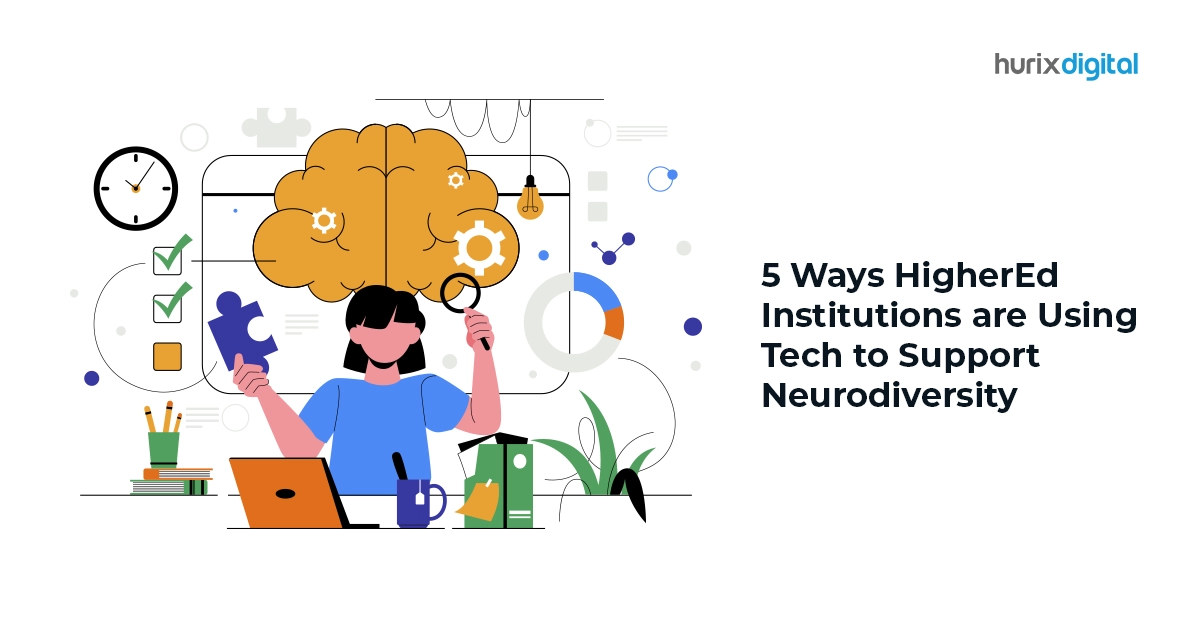
5 Ways Higher Ed Institutions are Using Tech to Support Neurodiversity
Summarize with:
Did you know that about 15-20% of the global population shows some form of neurodiverse? But what does it mean to be so?
Well, neurodivergence is a term used to describe individuals whose brain processes information differently from the ordinary. This may be reflected in their social behavior, communication style, and learning style.
In some cases, neurodivergence may also mean the person has a medical condition, like Attention-Deficit/Hyperactivity Disorder (ADHD), Autism Spectrum Disorder (ASD), or dyslexia. However, it also has its benefits—such individuals tend to have a better memory, observational skills, and a knack for music, art, technology, etc.
These contrasts make neurodivergent individuals different from the rest. Thus, higher education institutions are constantly implementing innovative technology to accommodate their unique needs and maximize their learning efficiency.
So, if you are a higher education institution that also aims to facilitate such neurodiversity, read this blog as we discuss its pros and list the tools and tech you need to do so. Let’s start!
Table of Contents:
- What is Neurodiversity?
- What are the Benefits of Embracing Neurodiversity in HigherEd Institutions?
- 5 Cutting-Edge Tools HigherEd Institutions Use to Support Neurodiversity
- Wrapping Up
What is Neurodiversity?
Neurodiversity is a concept that embraces and celebrates neurodivergent individuals in society. It is based on the key principles of inclusion and acceptance.
Neurodiversity seeks to eliminate social stigmas surrounding neurological brain conditions like ASD, ADHD, and dyslexia and educate people about them. Additionally, it aims to recognize the strengths and weaknesses of neurodiverse individuals and impart special education to them to hone their skills.
Also Read: 10 Tips for Choosing the Right Educational Games for K12 Curriculum
What are the Benefits of Embracing Neurodiversity in HigherEd Institutions?
Neurodiverse individuals are full of untapped potential—sometimes even the kind that can prove revolutionary. Thus, as a higher education institution, embracing their differences can bring about several benefits for you. For instance:
1. Enhances Learning Environments
Every neurodivergent individual has different learning needs. A student with ADHD might require different tools to learn a topic than someone with dyslexia. This necessitates the implementation of personalized learning techniques in the institution. Education personalization has always bestowed incredible benefits.
2. Fosters Diverse Perspectives
Unlike normal individuals whose imaginations are limited to 2D visualization, some neurodivergent individuals can visualize scenarios in 3D!
This shows that neurodivergent individuals harbor drastically different perspectives and thinking, which also greatly impacts how they approach a problem. So, creating adaptive learning environments for neurodivergent individuals can enable institutions to foster these diverse perspectives and make new discoveries.
3. Promotes Skill Diversity
The differences in the brain function of neurodivergent individuals also impact their strengths and weaknesses.
These people tend to be better at picking details, recognizing patterns, solving complex mathematical equations, etc. By embracing their learning needs, you get the opportunity to hone these skills and create the next generation of great minds while also fostering student success.
4. Build a Diverse Workforce
As per stats, diverse organizations are 35% more likely to perform better than others. However, creating such a workforce tends to be a bottleneck for many of them simply because of the lack of inclusivity at the educational level.
Thus, when you accommodate the unique learning requirements of neurodivergent individuals, you are making them job-ready, thereby also constituting in building a diverse workforce for your economy.
5. Improves Students’ Mental Health
Last but not least, embracing neurodiversity at an institutional level helps spread awareness about it. Moreover, it also eliminates the social stigmas associated with the neurodivergent population, which greatly impacts the students’ mental health and overall well-being.
5 Cutting-Edge Tools HigherEd Institutions Use to Support Neurodiversity
Now that you know about the advantages of incorporating neurodiversity in higher education institutions, here are some educational technologies and tools that can help you leverage them:
1. Artificial Intelligence (AI)
Personalization is the core of neurodivergent education. To implement this, institutions employ the robust technology of Artificial Intelligence. With the help of AI-powered adaptive learning tools and solutions, educators are better able to disseminate customized pedagogy for seamless neurodiversity support.
2. Virtual Reality (VR) and Augmented Reality (AR)
Immersive learning has many benefits. For instance, it enhances retention, fosters easy comprehension, offers the benefits of personalization, and much more. Institutions that embrace neurodiversity reap these advantages by utilizing AR and VR tools like headsets, glasses, etc.
This not only enables them to provide an engaging learning experience to students but also supports those with ADHD and similar conditions who might struggle with traditional learning.
3. Eye-Tracking Technology
An eye tracker is a device that tracks the direction of a person’s eyes. It is a type of assistive technology that mainly helps institutions note the observation patterns of neurodivergent students.
This further enables them to devise teaching systems and processes that best facilitate their learning and engagement with a piece of content.
4. Speech Recognition Tool
Students with dyslexia have trouble writing, but nonetheless, they have endless potential. To reap that potential, neurodiverse educational institutions use speech recognition tools. This way, such students can easily convert their thoughts and ideas into written text through speech and avoid having to write them down.
5. Collaborative Learning Management System (LMS)
Collaboration is yet another skill neurodivergent individuals usually tend to struggle with. However, to ease that, neurodiverse institutions employ collaborative learning management systems (LMSs). These tools support multiple contributions at once. This enables students to work as a team and develop their collaboration skills.
Check out EXCLUSIVE: Hurix Digital Helps Prominent University Bridge the AI Knowledge Gap in Higher Education
Wrapping Up
Neurodiverse individuals have their own needs, especially when it comes to learning. For higher education institutions, embracing them is the first step to igniting an innovation in education that can potentially shapeshift the entire learning landscape.
So, don’t wait—employ the tech and tools mentioned above to make your institution neurodiverse.
If you’re looking for expert assistance in this regard, reach out to us at Hurix Digital. We host a range of innovative, cutting-edge Higher Ed & K12 Solutions that can help you build a neurodiverse learning ecosystem in no time.
Hurry up…get in touch today!
Summarize with:

Senior Vice President
A Business Development professional with >20 years of experience with strong capability to sell new solutions and develop new markets from scratch. New Market Entry Specialist with experience working in the largest emerging markets. Exceptional experience in conceptualizing, ideating and selling new learning technologies like VR AR, etc. across multiple industry verticals.
 A Space for Thoughtful
A Space for Thoughtful 



